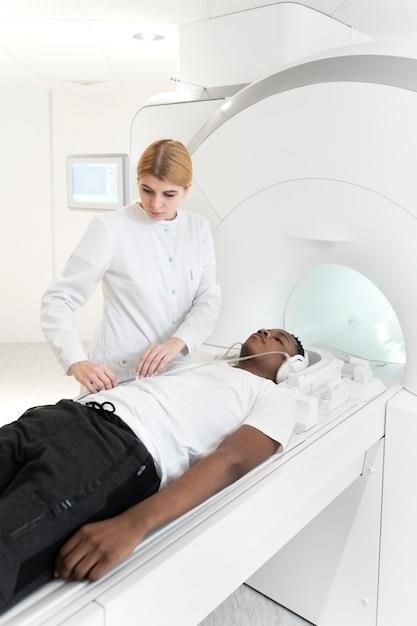image guided superficial radiation therapy
Image-Guided Superficial Radiation Therapy (IG-SRT)⁚ A Comprehensive Overview
Image-Guided Superficial Radiation Therapy (IG-SRT) is a cutting-edge‚ non-invasive treatment option for non-melanoma skin cancers‚ such as basal cell carcinoma and squamous cell carcinoma․ This advanced technique utilizes low-energy X-rays to precisely target and destroy cancerous cells while minimizing damage to healthy surrounding tissue․ IG-SRT is a safe‚ effective‚ and minimally invasive alternative to traditional surgery‚ offering patients a less disruptive and potentially quicker recovery․
Introduction
Skin cancer is a prevalent health concern‚ with non-melanoma skin cancers (NMSCs)‚ specifically basal cell carcinoma (BCC) and squamous cell carcinoma (SCC)‚ being the most common types․ Traditional treatment options for NMSCs often involve surgical excision‚ which can lead to scarring‚ disfigurement‚ and discomfort․ In recent years‚ Image-Guided Superficial Radiation Therapy (IG-SRT) has emerged as a promising alternative‚ offering a minimally invasive and highly effective approach to treating these skin cancers․ IG-SRT leverages the power of radiation therapy to target and destroy cancerous cells while preserving healthy surrounding tissue‚ minimizing the potential for scarring and promoting faster healing․
This comprehensive overview explores the intricacies of IG-SRT‚ delving into its mechanism of action‚ benefits‚ and efficacy․ We will examine how IG-SRT works‚ outlining its key components and the precision it offers․ We will also discuss the advantages of IG-SRT over traditional surgical approaches‚ highlighting its minimal invasiveness‚ shorter treatment times‚ and superior cosmetic outcomes․ Furthermore‚ we will explore the safety and efficacy of IG-SRT‚ presenting evidence from clinical studies and patient experiences․ Finally‚ we will compare IG-SRT to other treatment options‚ emphasizing its unique advantages and the growing body of research supporting its use in the management of NMSCs․
By providing a detailed and insightful analysis of IG-SRT‚ this article aims to empower both patients and healthcare professionals with a comprehensive understanding of this groundbreaking treatment modality․ It is our hope that this information will encourage further exploration of IG-SRT as a viable and effective option for patients seeking safe and effective treatment for NMSCs․
What is Image-Guided Superficial Radiation Therapy (IG-SRT)?
Image-Guided Superficial Radiation Therapy (IG-SRT)‚ also known as Image-Guided SRT‚ is a non-surgical treatment modality that utilizes low-energy X-rays to target and destroy cancerous cells in the superficial layers of the skin․ Unlike traditional radiation therapy‚ which uses higher energy beams to penetrate deep into the body‚ IG-SRT is specifically designed for treating skin cancers․ This precision ensures that only the cancerous cells are targeted‚ minimizing damage to healthy surrounding tissues․
IG-SRT is a highly advanced technique that combines the power of radiation therapy with real-time imaging guidance․ During the treatment‚ an ultrasound probe is used to generate images of the cancerous area‚ providing precise visualization of the tumor’s location and size․ This imaging data is then used to guide the delivery of radiation‚ ensuring accurate targeting and optimal treatment efficacy․ The integration of imaging guidance enhances the precision of the treatment‚ allowing for more accurate targeting of the cancerous cells and minimizing the risk of damage to healthy tissues․
IG-SRT is a relatively quick and painless procedure‚ typically requiring a series of short treatment sessions․ It is a minimally invasive alternative to surgical excision‚ offering patients a less disruptive and potentially quicker recovery․ Furthermore‚ IG-SRT has shown excellent cosmetic outcomes‚ minimizing scarring and preserving the natural appearance of the treated area․
How Does IG-SRT Work?
Image-Guided Superficial Radiation Therapy (IG-SRT) operates on the principle of delivering precise doses of low-energy X-rays directly to the cancerous cells in the skin․ The procedure involves a series of short treatment sessions‚ typically lasting only a few minutes each․ During each session‚ the patient lies comfortably on a treatment table‚ and the targeted area is carefully positioned using a specialized device that ensures precise alignment․
A key feature of IG-SRT is the use of real-time imaging guidance‚ typically ultrasound‚ to visualize the tumor’s location and size․ This allows the radiation therapist to precisely target the cancerous cells while minimizing damage to healthy surrounding tissues․ The ultrasound images are displayed on a monitor‚ allowing the therapist to continuously monitor the treatment and adjust the radiation beam as needed‚ ensuring optimal accuracy and effectiveness․
The low-energy X-rays used in IG-SRT are designed to penetrate only the superficial layers of the skin‚ where non-melanoma skin cancers are typically located; This targeted approach minimizes the risk of damaging underlying organs or tissues․ The radiation dose is carefully calculated and delivered in a series of fractions over a period of several days or weeks‚ allowing the healthy tissues to recover between treatments while effectively targeting the cancerous cells․
Benefits of IG-SRT
Image-Guided Superficial Radiation Therapy (IG-SRT) offers a compelling array of benefits for patients seeking treatment for non-melanoma skin cancers․ These benefits stem from the procedure’s precision‚ minimally invasive nature‚ and efficacy in targeting and destroying cancerous cells while preserving healthy tissues․
One of the key advantages of IG-SRT is its high cure rate․ Studies have demonstrated that IG-SRT achieves a cure rate exceeding 99% for appropriate basal and squamous cell skin cancers‚ making it a highly effective treatment option․ The procedure’s precision in targeting cancerous cells and its ability to minimize damage to surrounding tissues contribute to this impressive success rate․
Furthermore‚ IG-SRT offers a less invasive alternative to traditional surgical excision․ The procedure is performed on an outpatient basis‚ requiring no general anesthesia or lengthy recovery periods․ Patients typically experience minimal discomfort during treatment‚ and the recovery process is often faster and less disruptive compared to surgery․ This makes IG-SRT an attractive choice for patients seeking a less invasive and potentially more convenient treatment option․
Another significant benefit of IG-SRT is its excellent cosmetic outcomes․ The precise targeting of cancerous cells minimizes damage to the surrounding skin‚ resulting in less scarring and a better aesthetic result compared to surgical excision․ This is particularly important for patients concerned about the cosmetic impact of treatment on visible areas of the body․
IG-SRT for Non-Melanoma Skin Cancers
Image-Guided Superficial Radiation Therapy (IG-SRT) has emerged as a highly effective and versatile treatment modality for non-melanoma skin cancers‚ specifically basal cell carcinoma (BCC) and squamous cell carcinoma (SCC)‚ the two most prevalent types of skin cancer․ These cancers‚ often characterized by their slow growth and localized nature‚ are particularly well-suited for treatment with IG-SRT․
IG-SRT’s precision in targeting cancerous cells‚ minimizing damage to surrounding healthy tissue‚ and achieving high cure rates make it an attractive option for patients with BCC and SCC․ The procedure’s non-invasive nature‚ minimal discomfort‚ and relatively short treatment duration further enhance its appeal for individuals seeking a less disruptive and potentially faster recovery compared to traditional surgical approaches․
The use of IG-SRT for non-melanoma skin cancers is supported by a growing body of clinical evidence demonstrating its efficacy and safety․ Studies have shown that IG-SRT achieves high cure rates for BCC and SCC‚ often exceeding 99%‚ making it a highly effective treatment option for these common skin cancers․ Furthermore‚ the procedure has been shown to be safe‚ with minimal side effects and a low risk of complications․
IG-SRT offers a valuable alternative to traditional surgical excision for patients with non-melanoma skin cancers‚ providing a less invasive‚ potentially faster recovery‚ and high cure rate․ Its precision‚ safety‚ and effectiveness have solidified its position as a leading treatment option for BCC and SCC․

The Procedure⁚ What to Expect
The IG-SRT procedure is typically a straightforward and minimally invasive outpatient treatment․ During your initial consultation‚ your healthcare provider will thoroughly discuss the procedure‚ answer any questions you may have‚ and ensure you understand the potential benefits and risks․ You will be asked to sign an informed consent form‚ signifying your understanding and agreement to proceed with the treatment․
The treatment itself is usually painless and involves a series of short sessions‚ typically lasting only a few minutes each․ Before each session‚ a highly trained radiation therapist will use precise imaging techniques‚ such as ultrasound‚ to pinpoint the exact location of the cancerous lesion․ This ensures that the radiation is delivered directly to the target area‚ minimizing exposure to surrounding healthy tissue․
The radiation therapist will then position a specialized applicator‚ similar to a small hand-held device‚ over the cancerous lesion․ This applicator delivers the low-energy X-ray beams in a controlled and precise manner‚ targeting the cancerous cells while sparing healthy tissue․ The treatment sessions are typically spaced out over a few weeks‚ with the exact number of sessions determined by the size and location of the cancer․

After the treatment‚ you will be able to return to your normal activities immediately․ There is generally no need for anesthesia‚ and the procedure is often described as feeling like a mild warming sensation․ You may experience some minor redness or irritation at the treatment site‚ but these side effects are usually temporary and resolve quickly․
Safety and Efficacy of IG-SRT
IG-SRT has been extensively studied and proven to be a safe and effective treatment option for non-melanoma skin cancers․ Multiple clinical trials and studies have demonstrated its high cure rates‚ often exceeding 99% for basal cell carcinoma and squamous cell carcinoma․ This makes IG-SRT a highly promising alternative to traditional surgical treatments‚ particularly for patients who may not be ideal candidates for surgery due to age‚ health conditions‚ or location of the cancer․
One of the key advantages of IG-SRT is its precision and minimal side effects․ The use of advanced imaging techniques ensures that the radiation is delivered directly to the target area‚ minimizing exposure to surrounding healthy tissue․ This targeted approach significantly reduces the risk of complications associated with traditional radiation therapies‚ such as skin damage‚ scarring‚ or burns․ Most patients experience minimal side effects‚ which are typically mild and temporary‚ such as redness or irritation at the treatment site․
Furthermore‚ IG-SRT is a non-invasive treatment‚ meaning that it does not involve any cutting or incisions․ This makes it a particularly appealing option for patients who are seeking a less invasive approach to their cancer treatment․ The procedure is usually performed in an outpatient setting‚ allowing patients to return home on the same day and resume their normal activities quickly․ IG-SRT has also been shown to offer excellent cosmetic outcomes‚ often preserving the natural appearance of the treated area․
IG-SRT Compared to Other Treatment Options
IG-SRT offers distinct advantages over other treatment options for non-melanoma skin cancers‚ such as surgery‚ cryosurgery‚ and topical treatments․ While surgery remains the gold standard for many skin cancers‚ it can be invasive‚ potentially leading to scarring‚ disfigurement‚ or complications․ Cryosurgery‚ which uses freezing temperatures to destroy cancerous cells‚ can also cause scarring and may not be suitable for all types of skin cancers or locations․ Topical treatments‚ such as creams or gels‚ may not be as effective as other options and can sometimes cause irritation or allergic reactions․
IG-SRT stands out as a less invasive and more precise alternative to these methods․ Its targeted radiation delivery minimizes damage to healthy tissue‚ reducing the risk of complications and promoting faster healing․ The non-invasive nature of IG-SRT also makes it a more comfortable and convenient option for many patients‚ particularly those who are hesitant about surgery or other invasive procedures․ Additionally‚ IG-SRT often offers superior cosmetic outcomes compared to other treatments‚ preserving the natural appearance of the treated area․
However‚ it’s important to note that IG-SRT may not be suitable for all patients․ The best treatment option for each individual depends on factors such as the type and stage of the cancer‚ the location of the tumor‚ and the patient’s overall health and preferences․ A thorough consultation with a qualified dermatologist or oncologist is essential to determine the most appropriate course of treatment․
Image-Guided Superficial Radiation Therapy (IG-SRT) has emerged as a valuable and increasingly popular treatment option for non-melanoma skin cancers․ Its non-invasive nature‚ precise targeting‚ and minimal side effects offer a compelling alternative to traditional surgical interventions․ The high cure rates and excellent cosmetic outcomes associated with IG-SRT make it a viable and attractive choice for many patients․ Furthermore‚ the growing body of research supporting the efficacy and safety of IG-SRT further strengthens its position as a leading treatment modality․
However‚ it’s crucial to remember that IG-SRT is not a one-size-fits-all solution․ The suitability of IG-SRT for each individual case depends on various factors‚ including the type and stage of the cancer‚ the location of the tumor‚ and the patient’s overall health and preferences․ As with any medical treatment‚ a thorough consultation with a qualified dermatologist or oncologist is essential to determine the most appropriate course of action and ensure the best possible outcome for the patient․
As research and technology continue to advance‚ IG-SRT is likely to play an even more significant role in the management of non-melanoma skin cancers‚ offering patients a safe‚ effective‚ and minimally disruptive treatment option․
References
“Freedom from Recurrence across Age in Non-Melanoma Skin Cancer Treated with Image-Guided Superficial Radiation Therapy‚” The International Journal of Radiation Oncology‚ Biology‚ Physics‚ 2024․
“Image-Guided Superficial Radiation Therapy (IGSRT) for the Treatment of Early-Stage Non-Melanoma Skin Cancer (NMSC)⁚ A Comprehensive Review‚” Dermatologic Surgery‚ 2024․
“SkinCure Oncology‚ the World Leader in Providing a Comprehensive Model for the Delivery of Image-Guided Superficial Radiation Therapy (Image-Guided SRT)‚” PRNewswire‚ 2024․
“An Image-Guided Form of Superficial Ionizing Radiation Therapy (IGSRT) is Becoming a Commonly Used Alternative to Surgery for Non-Melanoma Skin Cancer (NMSC)‚” Dermatologic Surgery‚ 2024․
“Image-Guided Superficial Radiation Therapy (IG-SRT)‚” SkinCure Oncology‚ 2024․
“Image-Guided Superficial Radiotherapy (SRT)⁚ A Non-Surgical Option for Treating Basal and Squamous Cell Skin Cancers‚” GentleCure‚ 2024․
“Image-Guided Superficial Radiation Therapy (IG-SRT)‚” Advance Dermatology & Laser Medical Center‚ 2024․
“Image-Guided Superficial Radiation Therapy (IG-SRT)‚” Xstrahl‚ 2024․
“Image-Guided Superficial Radiation Therapy (IG-SRT)‚” ESTRo‚ 202


